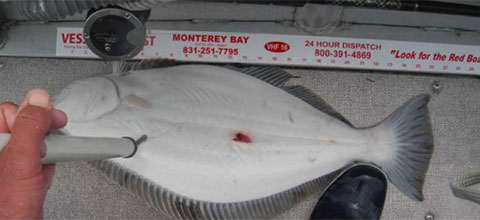Authors:
Oren T. Frey, Andrew P. DeVogelaere, Monterey Bay National Marine Sanctuary
Geoff Shester, Oceana

Many commercially-targeted fish species can be caught with different types of fishing gear, yet the choice of fishing gear can have major economic and ecological repercussions. California halibut (Paralicthys californicus) is a major commercial and recreational fish species in California and Mexico that can be commercially caught with bottom trawls, set gillnets, and various configurations of hook and line gear. Numerous studies have documented adverse impacts to seafloor habitats from the use of bottom trawls, including the 2002 National Research Council study which found that bottom trawling reduces the diversity, productivity, and complexity of marine habitats. To comply with Essential Fish Habitat provisions of the 1996 Sustainable Fisheries Act, the Pacific Fishery Management Council closed over 135,000 square miles of federal waters to bottom trawling off the U.S. west coast in the 2006 Pacific Coast Groundfish EFH Final Rule. Also in 2006, halibut trawl grounds in Monterey Bay, California became closed to trawling as the result of 2004 state legislation (SB 1459), and there has been ongoing debate about whether to reopen certain areas. Meanwhile, the California Fish and Game Commission is required to "facilitate conversion of bottom trawling to more sustainable gears." However, while hook and line gear clearly has been shown in other studies to cause minimal impacts to seafloor habitats compared to trawling, little is known about the economic viability or the levels of incidental catch associated with hook and line fishing for California halibut.
The objective of this pilot study is to provide a preliminary snapshot characterization of the California halibut fishery currently taking place in northern Monterey Bay, California with hook and line gear, focusing on costs and revenues to participating fishermen, spatial patterns in fishing effort, and incidental catch. The intent is to contribute additional information to ongoing dialogue regarding the relative impacts of hook and line fishing gear and the potential to increase landings with this gear type in Monterey Bay. We identified three California halibut hook and line commercial fishermen to collect data while at-sea in the course of normal fishing operations and participate in extensive semi-structured interviews. While at sea, these fishermen continuously tracked their vessel location with GPS, and for each individual organism caught they recorded data: the GPS location where caught, the species identity, the total length, a still photograph, whether the organism was retained or discarded, and the condition of each discarded fish. We conducted semi-structured interviews with participating fishermen at the conclusion of the at-sea component of the study, which addressed perceptions and opinions, experience in the fishery, interpretations of data gathered in the at-sea components, personal economics associated with the fishery, and fishery trends. Fishermen were compensated for their sharing of information in the study, and to compensate for any reduced income that may have resulted from recording data.
Data were collected during 14 trips from August to November 2011, representing the latter half of the 2011 halibut season for this fishery. Fishermen typically fished alone (i.e., without crew) on small vessels from 15-18 feet long by drifting live bait on 3-6 lines at a time. Fishing effort occurred within 5 miles of the Santa Cruz Harbor at less than a dozen discrete locations throughout the study. A total of 38 California halibut were caught, of which 36 were of legal size and 2 were sublegal. Ex-vessel prices ranged from $4-6/lb for whole halibut, landed dead. Aside from halibut, other commonly retained species included lingcod, brown rockfish, gopher rockfish, copper rockfish, and sand sole. Overall, discard rates observed in this study were 19.5% of the total catch by weight. Discards were exclusively finfish. On an annual basis, the most significant costs included boat maintenance, tackle, licenses, and fuel. Based on a combination of recorded landings in the study and subsequent interviews to determine costs, estimates of annual earnings per fisherman from halibut fishing ranged from $11,295 to $29,362 representing approximately 20-25% of each fisherman's total annual income. However, while the fishery is currently open access, there appear to be significant barriers to entry, particularly the technical difficulty associated with successfully using hook and line fishing gear to target this species.
This preliminary study indicates that the hook and line fishery for California halibut in Monterey Bay is an economically viable commercial fishery that may have substantially less bycatch than what has been reported in other studies of bottom trawling for this species. This pilot study also indicates that collaborative research involving fishermen as participants and data gatherers provides significant opportunities to collect important, management-relevant data that may otherwise be cost-prohibitive.
Key Words:
California halibut, hook and line, sustainable fisheries, collaborative fisheries research, Santa Cruz, Monterey Bay National Marine Sanctuary, MBNMS

